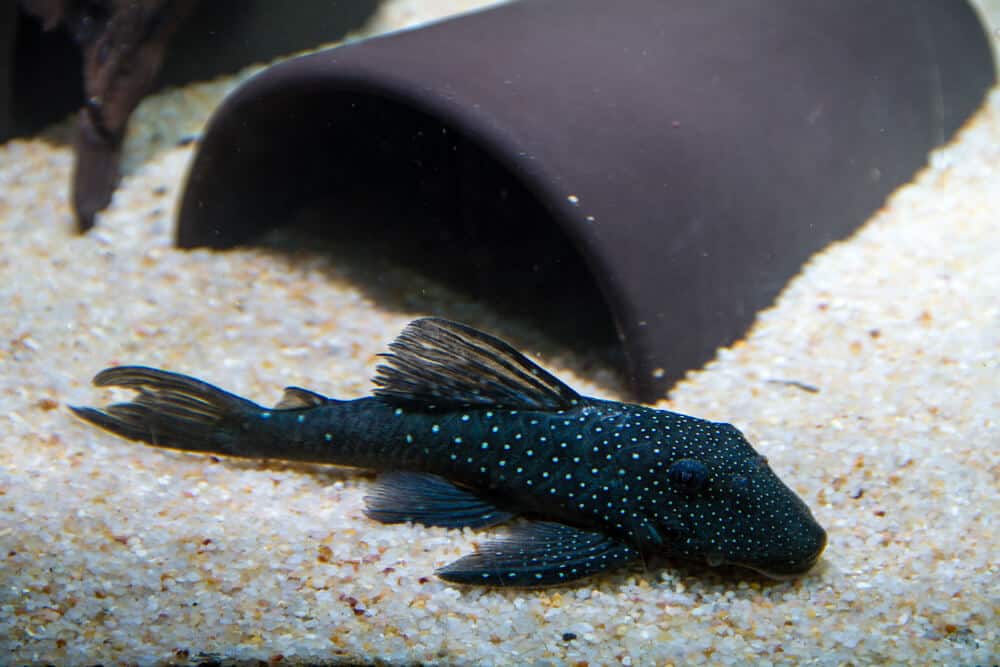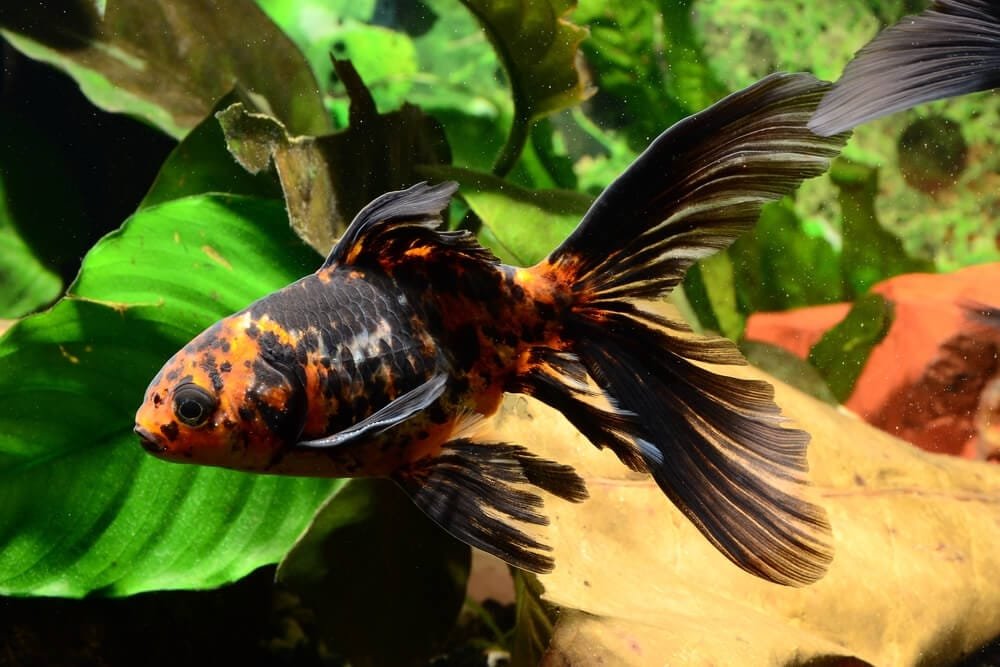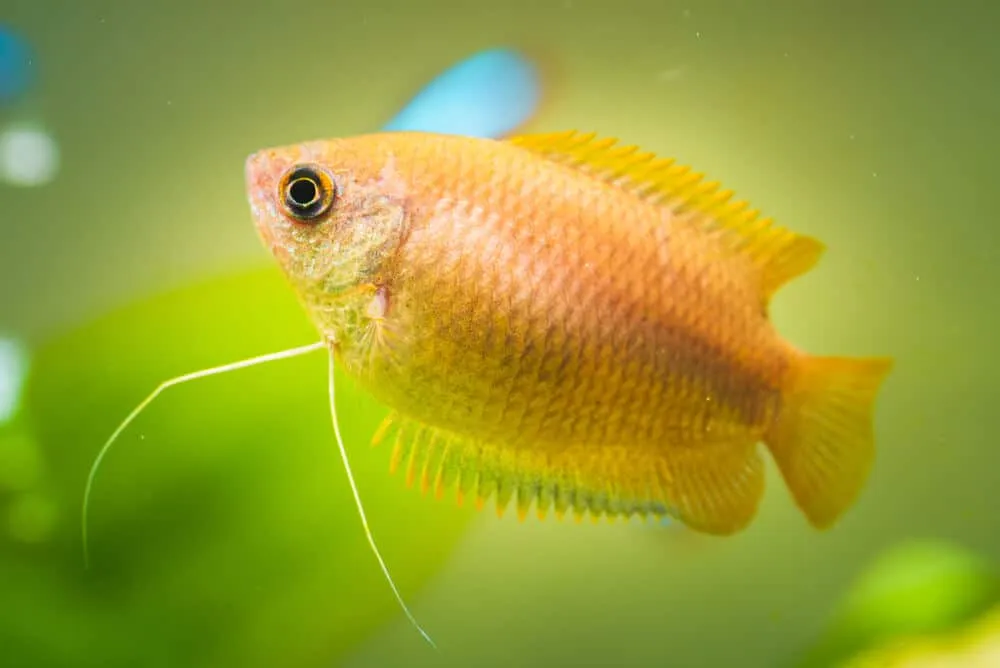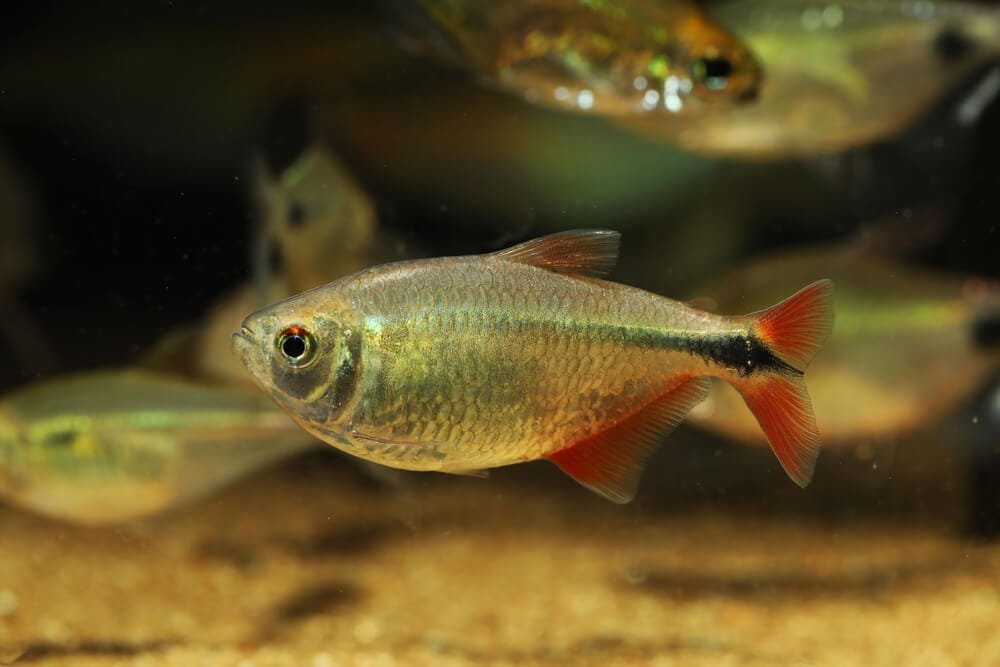
Species Overview
Common Names: Blue Phantom Pleco, Pleco L128
Scientific Name: Hemiancistrus sp.
Adult Size: 7 inches
Life Expectancy: 10 years
Characteristics
Family: Loricariidae
Origin: Venezuela
Social: Peaceful to semi-aggressive
Minimum Tank Size: 50 gallons
Diet: Omnivore
Breeding: Egg-layers
Care: Moderate
pH: 6.0 to 7.5
Hardness: 2 to 12 KH
Temperature: 75 to 86°F
Have you been wondering what type of beautiful fish will suit your aquarium? This fish species is the best answer.
With its bright blue body sprinkled with white dots, the Blue Phantom Pleco makes for a very attractive fish to keep in your tank. The Phantom Pleco is also a very active fish that loves swimming in its tank.
It’s definitely an excellent addition to any aquarium and can be very entertaining.
This article will help you look at everything you need to know about this type of fish. We look at the size, the habitats, the appearance, the compatibility and all the interesting facts about this fish.
Keep on reading for more.
Blue Phantom Pleco Overview
This is a fish species found in the Amazon River basin in South America. It is also known as L128.
It grows to a length of up to 7 inches. It can also be a bit territorial as it will not hesitate to attack other fish who come too close and make them feel threatened.
The Phantom Pleco is a popular aquarium fish because it has a cheerful temperament and is easy to care for. It can be kept in either tropical or temperate water conditions and should be fed small pieces of meat, vegetables, and fruit.
Its amicable disposition and ability to coexist peacefully with other fish make it a popular choice for community fish tanks.
Any significant factors do not currently threaten the Blue Phantom. Still, its population may be declining due to the expansion of the Amazon River basin into new areas and the loss of habitat due to deforestation.
If you are interested in keeping this fish as an aquarium pet, please be aware that it requires ample space for its activeness. If you are considering buying this fish, please research first to ensure it is a suitable pet.
Origin And Classification
The fish is from kingdom Animalia, phylum Chordata, subphylum Vertebrata, class Teleostei, order Siluriformes, and family Loricariidae. The genus of the fish is Hypostomus, and the species name is Hypostomus Plecostomus L.
It is believed to have been introduced to other parts of the world through the aquarium trade. It is not known to have established populations outside of its native range.
However, it is possible that individuals could escape from aquariums and establish populations in other parts of the world.
Habitat
The blue phantom is a natural freshwater fish that prefers to live in slow-moving waters, such as rivers, creeks, and lakes. They can also survive in acidic soft waters.
They are primarily found in Rio Orinoco in the downstream area of Puerto Ayacucho.
The blue phantom is a nocturnal fish, meaning that it is most active at night. During the day, these fish will hide in caves or among the roots of plants.
The fish species is a bottom-dweller, meaning that it spends most of its time exploring the depths of the water.
This fish is an omnivore and will eat small fish, invertebrates, and plant matter. The habitat of the blue phantom is essential for this fish because it helps to ensure that this species has access to food and shelter.
This fish is not tolerant of changes in its environment, so it is essential to keep its habitat consistent if you want to keep a specimen of this fish.
Water Parameters
According to the origin of the fish species, they are used to string water currents. They can, however, adapt easily to the mild movement of water.
This type of fish prefers warm waters with temperatures between 77 to 84 degrees. The pH level is acidic from 6.0 to 7.0.
You need to be extra careful with this as this fish species tend to die when the water becomes alkaline.
The fish is also highly sensitive to sudden changes in water quality or quantity. The water should be kept at the same level with adequate oxygen.
The water conditions are tested using the kit to keep track of the conditions required.
Appearance And Size
Their name comes from their body color: blue and beautifully stunned with white spots. They possess a typical shape of the plecos’ body.
Their dorsal fins are upright with a flat head and their mouth is modified to suck and dig. They also have abdominal solid and pectoral fins for digging deeper into the rocks.
The juveniles are 3 to 5 inches long. The mature ones are averagely 7 inches.
They have no scales, a unique feature that allows them to have plates for protection.
Care
The fish is easy to care for and is an excellent option for beginners interested in pet fish. You only need to provide plenty of fresh water with a moderate current and adjust the pH to 6.5-7.0.
You also need to remove uneaten food and debris from their tank daily or regularly.
However, you are required to use an aquarium heater in the winter if necessary to maintain a comfortable temperature range (around 75-80 degrees Fahrenheit).
Another thing to keep in mind is that blue phantom are omnivorous fish, so they require a diet mainly of meat and plant materials. They will also eat small aquatic invertebrates, but make sure you provide them with plenty of fresh food and vegetable matter too.
Substrate
It is a freshwater fish that requires a substrate of sand, gravel, or rocks. Plants are not necessary but can be used for decoration to make their environment natural in the aquarium.
This fish does best in an aquarium with plenty of hiding places. It may become aggressive when its territory is invaded by other plecos.
Sand and gravel are required because the fish feeds on small invertebrates that live in the sand and gravel. A filtration system is also necessary to keep the fish clean and healthy.
However, harsh gravels should be avoided so they don’t accidentally injure their fins.
Behaviour And Temperament
The fish species will be most active at night and reduces their activities during the day. They are popular in an aquarium because of their hardiness and beautiful pattern.
They prefer to stay hidden most of the time.
They are shy, but when they are comfortable in their habitat, they will come out of hiding. They are good community fish and can survive well with others.
But, they are a little sensitive to changes in the water quality, so it is advised to do frequent water changes to maintain the quality of the water.
They are also sensitive to medications, so caution is advised when treating them with any medication. The fish requires a temperature of 75 to 82 degrees Fahrenheit with a pH of 6.8 to 7.4 and a hardness of 2 to 12 dGH.
Breeding
The fish are livebearers in that they lay eggs. The female and males should be put in the same tank to facilitate this process.
Tanks that are 48 inches long are recommended because of the fish’s size. A small tank will only accommodate both males and females if they have enough spaces to hide and find their happy space in case of threats.
The young ones will be hatched in 24 hours, and the females should be fed frequently. The juveniles are many at the time of hatching, and a good number of them do not survive to maturity.
This may be because of elimination by nature or being fed on by other larger species.
The juveniles become adaptive at almost three weeks of age and start moving around the tank. This movement behaviour reduces their tendency to be fed on.
They grow rapidly during their first trimester, and they are transferred to their own aquarium. They then mature after one year and start spawning themselves.
Lifespan
The lifespan of the fish is typically around 10 years. However, some individuals have been known to live up to 15 years in captivity.
In the wild, their lifespan is shorter due to predation and other environmental factors. Plecos are generally sensitive and adaptable fish, so if their environment is maintained healthily, they should be able to live quite a long time.
Tank Requirements And Level
This is a bottom dweller small tropical fish that needs a lot of space to live comfortably. It needs at least 1 inch of water above its base and a tank size of at least 50 gallons minimum.
The pleco also requires hiding places and rocky surfaces to rest on.
Water changes every two weeks are also necessary for a blue phantom. Plecos are hardy and easy to care for, but they do require regular water changes to maintain good health.
The tank should be naturally set up with rocks to allow the growth of algae which is food for the fish. The tanks should be supplied with protein supplements for their good health.
Parasites And Diseases
Parasites
Some of the parasites that can affect this fish species are ich, velvet, flukes, and tapeworms. These parasites can cause a variety of problems for the fish, including irritation, weight loss, and death.
It is important to treat any fish that is infected with parasites as soon as possible to prevent the spread of the parasites to other fish.
The parasites of the blue phantom pleco can be controlled using dips and good quality fish food. Some other methods that can be used to control parasitic infections in these fish include using a water change schedule, treating with anti-parasitic medication, and keeping the aquarium clean.
Monitoring for signs of disease is also important, as is cleaning up any debris that may build up over time. In some cases, surgery may be necessary to remove parasites from the fish’s body.
Diseases
This fish species is susceptible to many diseases, and these diseases make them uncomfortable or unable to thrive well. Such diseases include bacterial infections, fungal infections, viral infections, and parasites:
- Bacterial infections:
Bacterial infections are one of the most common diseases that can affect blue phantoms. These infections can cause a variety of symptoms, including fin rot, mouth rot, and ulcers.
Bacterial infections are often treated with antibiotics.
- Fungal infections:
Fungal infections can also be a major problem for the plecos. These infections cause lesions, discolouration on the fish’s skin, and serious health problems.
Fungal infections are treated often using antifungal medications.
- Viral infections
Different viruses result in various diseases in this type of fish. Plecos are especially vulnerable to these viruses, so it’s important to keep them healthy to prevent any illness.
The viral diseases commonly affecting plecos include:
- Respiratory infections (like pneumonia)
- CCD (coccidiosis)
- viruses that cause cancer (such as hepatitis A and B)
- diarrhea
There is no cure for any of these viruses, so it is important to keep your pleco healthy by following a proper fishkeeping regimen and making sure they have access to clean water and food.
If you notice any unusual behaviour or signs of illness in your pleco, be sure to take them to a veterinarian for diagnosis and treatment. Prevention is the best way to keep your plecos healthy!
Treatment Of The Diseases
The diseases that this fish species might suffer from can be controlled by giving the fish antibiotics and chlorine. It is important to do regular water changes and feed them a healthy diet in order for them to stay healthy.
Any presence of symptoms of the disease, such as reduced activity or poor health, should prompt you to take your fish to a qualified doctor immediately for diagnosis and treatment.
Predators
There are many predators that can affect this interesting fish. These predators can cause the fish to become stressed and even die.
Therefore, it is essential to be aware of the potential predators in your area and take steps to protect your fish and allow its life span to be longer. Some of the potential predators that could affect the fish include:
- Other fish:
Other fish, such as larger predatory fish, can be a threat to the fish species. They tend to feed on the plecos, or they destroy their habitat.
- Invertebrates:
Invertebrates, for instance, insects and worms, can also be predators of the blue phantoms. These invertebrates feed on the plecos or destroy their territory.
- Mammals:
Mammals, such as raccoons and cats, can also be predators of this fish species. These mammals can damage the plecos or also feed on them.
It is important to be aware of the potential predators in your area and take steps to protect your plecos. By doing so, you can help ensure that the Pleco population remains healthy and thriving.
How To Avoid Predators
There are a few things you can do to avoid predators in the blue phantoms aquarium. One is to make sure there are no places for predators to hide.
Another is to keep the pleco aquarium well-lit so predators cannot approach unnoticed. Not to mention, you will also be able to keep a closer eye on your pleco fish and be quick to respond to any that show signs of stress or injury.
Tank Mates And Compatibility
Compatibility in fish is when two different species of fish can live together in the same environment without harming each other. This can be due to the fish having similar dietary needs or because they can avoid each other’s territories.
Compatibility is essential for the health of both species, as it allows them to live in close quarters and share resources. It is also necessary for the environment, as it will enable different species to share resources and help to keep ecosystems healthy.
Compatibility can be challenging, as different fish species may have other behaviours and preferences.
Compatibility in this fish is generally reasonable. However, some individuals may not get along due to their different water parameters or tank sizes. Additionally, some variations in colour and pattern may also cause conflict.
If you are purchasing a pleco from a breeder or pet store, it is best to ask about their breeding history and whether any of the fish in the batch have been known to fight. If you are buying your pleco from a fish store or online retailer, ensure you get a picture of the fish before buying.
Blue Phantom Plecos are generally compatible with the following fish species.
- Cichlids
- Clown knife fish
- The silver dollars
- River stingrays
Benefits Of The Blue Phantoms
Compared to other species, Blue Phantoms offer great advantages to a lot of people. Aquarists typically prefer them because of the following reasons:
- They have an interesting appearance that catches the eye of any visitors.
- They are generally peaceful and get along well with other fish species, making them an ideal choice for community fish tanks.
- They can live long, with some of them surviving for twenty years or more.
- This fish species is also cheaper than others, making them a good option for aquarium owners on a tight budget.
- These fish are typically found in small to medium-sized aquariums and can be kept with other non-aggressive tropical fish.
- They are omnivorous and can feed on a variety of foodstuffs, including algae. This makes them easy to keep since you cannot lack something to feed them.
Frequently Asked Questions
Are these fish species nocturnal?
Yes, they are nocturnal. They are most active at night when they come out to feed on algae and other small food items.
During the day, they rest in the cover of rocks or in hiding spots. Some people keep plecos in lit tanks so they can see them, but most prefer to keep them in the dark tanks where they are more comfortable.
Are the fish species easy to breed?
Yes, they are easy to breed. The female will lay eggs on a smooth surface, and the male will fertilize them.
The eggs will hatch in about a week. The fry will require some attention, but they will grow quickly and are easy to care for.
They can be kept in a tank with plenty of plants and rocks or placed in a larger tank.
Are Blue Phantoms aggressive?
No, they are not. This type of fish is peaceful and can be kept with other fish species.
They may become territorial with other plecos but are not aggressive.
How big does this fish species get?
The fish grows to be about 4-7 inches long. They are a relatively small pleco compared to some of the other species.
Do they eat plants?
Some Plecos may be able to digest plant material, but it is not typically their preferred diet. Instead, they are more likely to consume small insects, worms, and other fish food items.
Which is the smallest pleco?
The medium size of the plecos is 2.4 inches. The smallest pleco, however, is the dwarf snowball species with a black body and white spots.
Can two plecos live together?
Yes, two plecos can live together. They are peaceful fish and get along with other fish.
However, they may fight if they are of the same species. It is best to keep them in a tank with other fish so they have something to do and are not bored.
How long do blue phantoms live?
The fish’s lifespan depends on several factors, including diet, water quality, and housing conditions. Generally speaking; however, they have a lifespan of between 10 to 12 years.
Some individual fish may live longer or shorter depending on the abovementioned factors. Ultimately, it is impossible to say exactly how long any fish will live.
However, by providing optimal care, you can help ensure that your blue phantoms enjoy a long and healthy life.
Final Words
It’s no surprise that this type of fish is increasingly becoming popular. With its unique and colorful appearance, as well as its peaceful temperament, most aquarium owners prefer keeping them in their tanks to other fish species.
Feeding and taking care of them is also a lot easier since they’re omnivorous. However, just like with any other fish, you need to be particular about their environment and make sure it’s regularly maintained.
The Blue Phantom Plecos are definitely a great addition to any home and would make a great pet for anyone. If you’re looking to add more variety and beauty to your fish tanks, then you can’t go wrong with this fish species.





